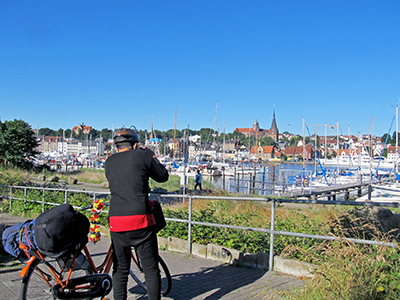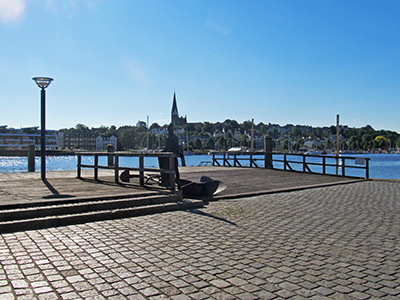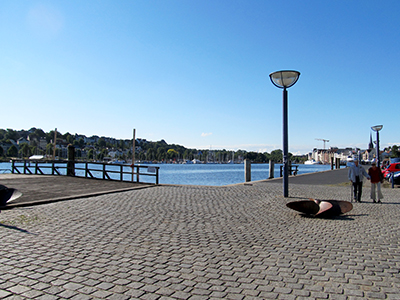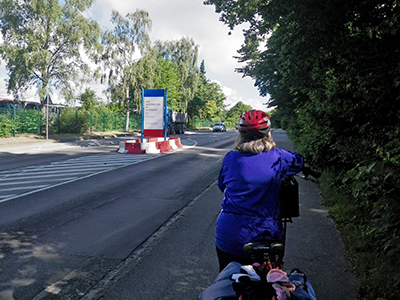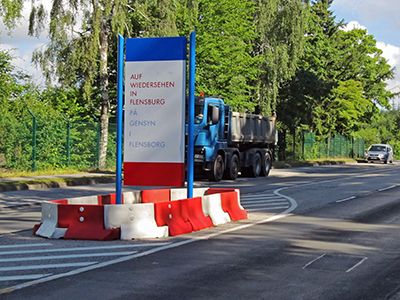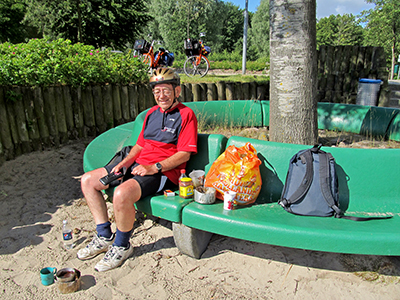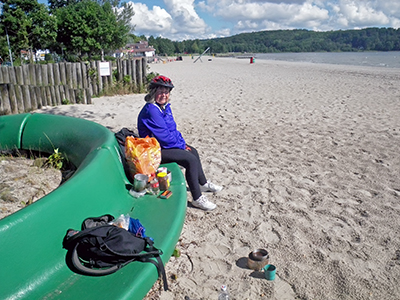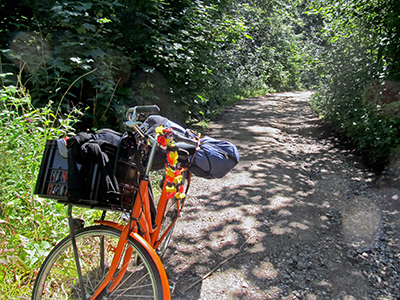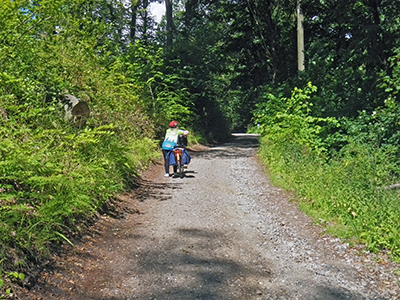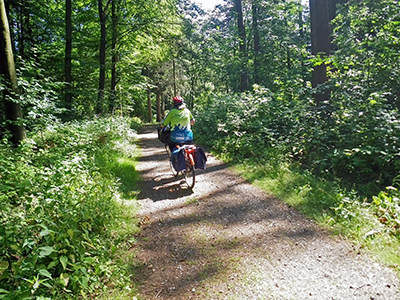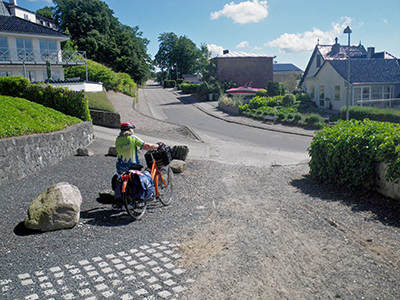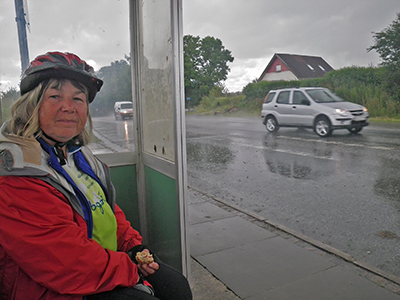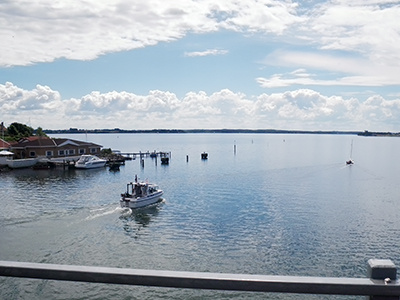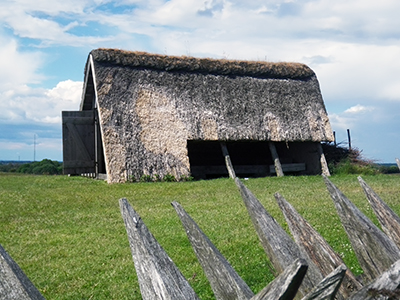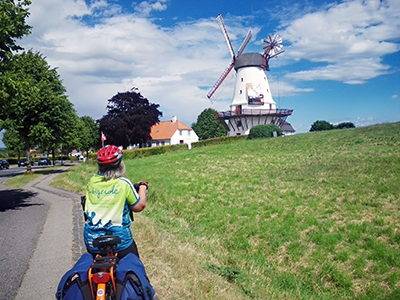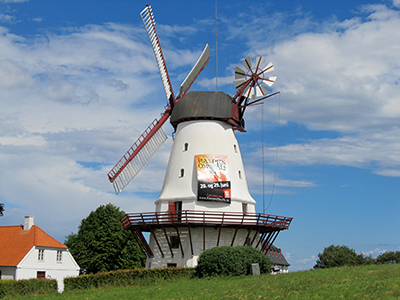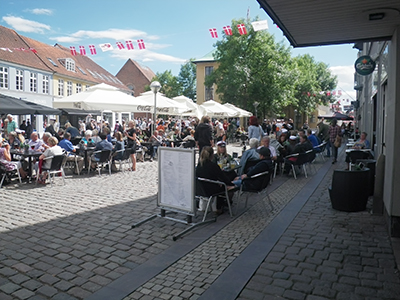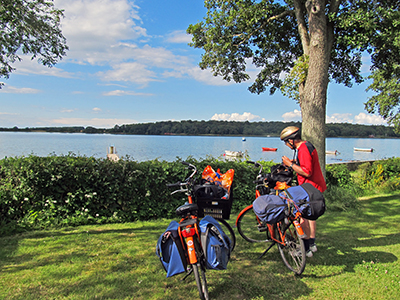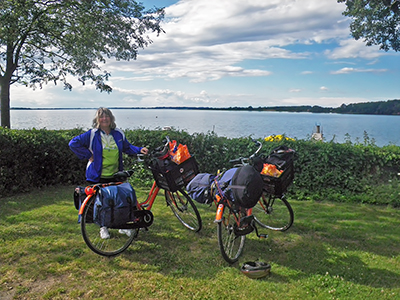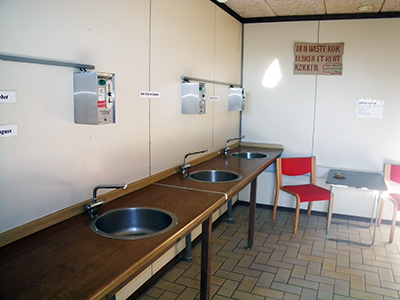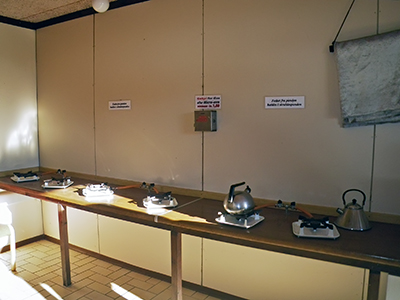Back to Don's Maps
Cycling from Amsterdam to Copenhagen
Day 14, 25th June 2014
51 km (713 km from the start)
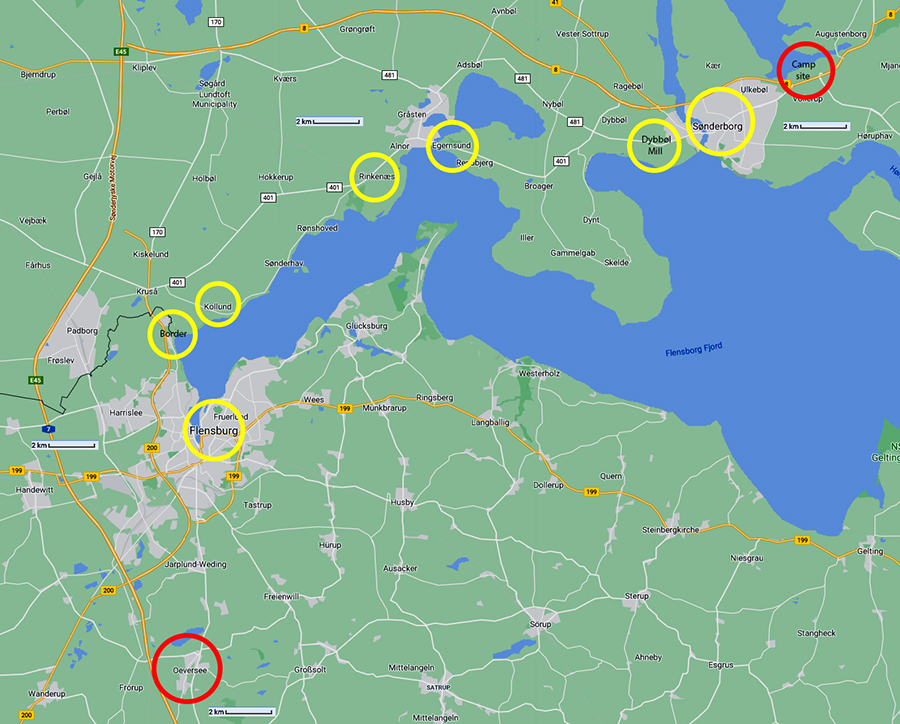
From Oeversee to Sønderborg, at the Augustenborg Fjord camp site
Photo: Google maps
From Maria's Diary:
Wednesday 25th June -
We left Oeversee and Fawlty Towers after the usual hotel breakfast and rode towards Flensberg. We headed for the harbour only to find that there was no ferry to the island of Funen, we would have to circumnavigate Flensburg Fjord to Sønderborg, and thence to the ferry at Fynshav, which would take us across to the island of Funen. This meant following the waterfront around.
It was a beautiful panorama that greeted us when we arrived at Flensburg harbour.
Photo: Don & Maria Hitchcock 0833h 25th June 2014
The harbour had many pleasure craft.
It was quite cool early in the morning despite the blue skies and sunshine, so I had rugged up with my lightweight but warm bushwalking clothing.
Photo: Don & Maria Hitchcock 0833h 25th June 2014
The foreshore of the harbour was beautifully presented.
Photo: Don & Maria Hitchcock 0847h 25th June 2014
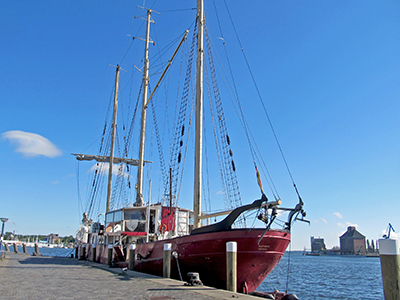
The Sunthorice, out of Rostock, is a three masted schooner which is available for charter.
It has had an interesting history.
Built in 1902 as a floating buoy and as a point of reference for seamen in the Deutsche Bucht and the Ems estuary, the lightship was equipped with light and radio beacons, a fog siren, and radar, and until 1932 had no auxiliary engines, but was a 3-masted sailing ship.
After many refurbishments and alterations, she was fitted out as a charter yacht in 2001, and has been well looked after since that time.
Photo: Don & Maria Hitchcock 0833h 25th June 2014
Additional text: http://www.tallship-fan.de/cgi-bin/tallship_e.pl?ACTION=DISPLAY&SCHIFFSID=300
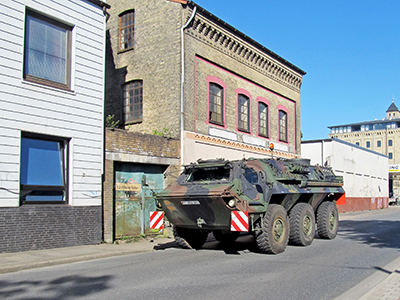
Tanks are a much more normal part of life in Germany and Denmark than in Australia, where they are never on public roads.
This one has been fitted out with rubber tyres, in lieu of the normal steel tank treads/continuous track, to avoid damage to roads.
Photo: Don & Maria Hitchcock 0852h 25th June 2014
Leaving Flensburg, on the way to Sønderborg. Road signs tend to be in Danish and German in Denmark, while Museum cards are usually in Danish and English.
Photo: Don & Maria Hitchcock 0933h 25th June 2014
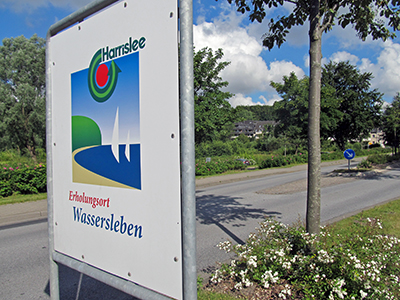
Approaching Harrislee, a beach resort on the Fjord.
Photo: Don & Maria Hitchcock 0939h 25th June 2014
It was strange to be on a beach again. Beach culture is a huge part of Australian life, we have many thousands of beautiful beaches, most with surf crashing in, except for those beaches which are protected by the Great Barrier Reef in Queensland.
Here there was no surf, and the sand as a result was very fine, the slope of the beach was very shallow, and there was no sign of the inland shrub and forest covered sand dunes which may be many thousands of years old, which are so much a part of an Australian beach.
Photo: Don & Maria Hitchcock 0939h 25th June 2014
I had jettisoned my outer layer by this time, but Maria was feeling the cool air, and was still in leggings and a coat.
I boiled up tea for Maria, then my 'mud', Turkish coffee, on my ultra lightweight home made and totally reliable stove system, and we had morning tea.
Photo: Don & Maria Hitchcock 0950h 25th June 2014
From Maria's Diary:
We met up with a large group of ladies on a bike tour. They recommended the Dammweg - big mistake - it was gravel and involved a very steep climb which just about did me in. Fortunately that section finished after a kilometre or so and we continued around the waterfront of Flensburg Fjord.

We packed up, and followed the coastline along a gravel path, the Dammweg, with much history, across a pedestrian bridge.
Photo: Don & Maria Hitchcock 1022h 25th June 2014
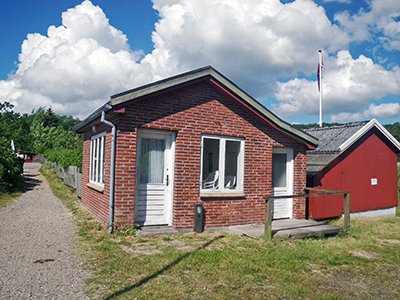
This is the former border crossing known as the 'Shoemaker's Hut' at the Danish end of the pedestrian bridge.
Photo: Don & Maria Hitchcock 1022h 25th June 2014
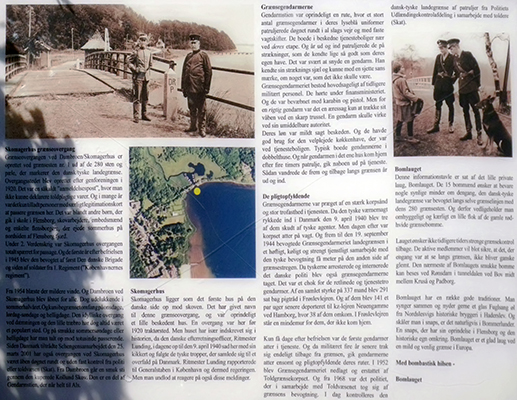
Shoemaker's house border crossing
The border station at the bridge to the 'shoemaker's hut' is situated at the boundary post number one out of the 280 stones and poles marking the German/Danish border. The crossing point was established in 1920 after a referendum under international supervision replaced the northern Schlesvig under Danish authority after 56 years under Prussian rule. It was just a second-rate station where goods could not be declared to the customs, and for many years, only people with a special identity card were allowed to cross the border here. It could be children living in Denmark but going to school in Flensburg, foresters, public officers, ore the few inhabitants of Flensburg still being owners of houses on the Danish side.
During WW2 the borderstation was totally closed. And in the first few years following the war it was closely guarded by the Danish armed forces. From 1954 things relaxed, and the little bridge was opened up for everybody holding a common passport - but only on the weekends in summertime. But the little idyllic borderstation at the dam quickly became a very popular place. On beautiful summer Sundays more than two thousand people would cross the bridge.
Since Denmark joined the Schengen cooperation in 2001 the borderstation here as with all other stations at the German/Danish border has been open day and night and without permanent control by police or customs. From the bridge a very beautiful path leads through the wood of Kollund. It is a part of the former observation route of the famous Danish gendarmerie. The route goes along the Flensburg Fjord and to the island of Als to the far east of here.
Photo: Don & Maria Hitchcock 1020h 25th June 2014
Text: Signs at the Shoemaker's Hut.
The gravel radweg became quite steep, and we had to walk part of the way. This part of the path, now in Denmark, is known as the Skomagerhusvej.
Photo: Don & Maria Hitchcock 1045h - 1048h 25th June 2014
But finally we were at the top, in a beautiful forest, then quickly returned to civilisation. At this point the path is known by the name Molevej, and we were entering the small town of Kollund.
Photo: Don & Maria Hitchcock 1059h - 1101h 25th June 2014
From Maria's Diary:
We then followed the yellow brick road which had some long rises - had to walk the bike up the worst ones. We met a German cyclist and had a great chat over an ice cream. I was looking for an ATM to get out some Danish money but they are as scarce as hen's teeth on the road. The best bet was to go to the major town of Sønderborg.
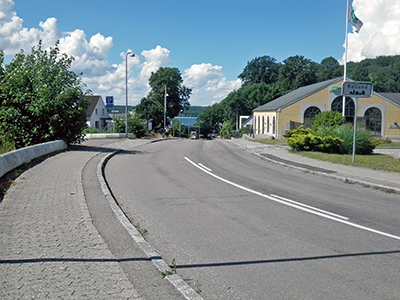
We seemed to be doing a lot of walking up hills ever since we got to Denmark. Here is a shot looking back the way we had come, to Kollund.
Photo: Don & Maria Hitchcock 1106h 25th June 2014
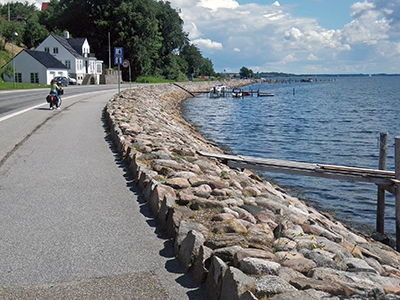
Flat radwegs along rivers and beside calm seas are a blessing.
Photo: Don & Maria Hitchcock 1130h 25th June 2014

We stopped to enjoy an ice cream at Fjordens Perle, while admiring the view and a beautiful white sports car, and talking to an interesting German cyclist.
Photo: Don & Maria Hitchcock 1208h 25th June 2014
Waiting for the rain to stop. Having occasional bus shelters was a boon on this trip.
We had had tea and coffee, and on the left I am reading a book on my Kindle. When the rain continued and then got heavier, right, we decided to call it lunch.
Photo: Don & Maria Hitchcock 1245h - 1302h 25th June 2014
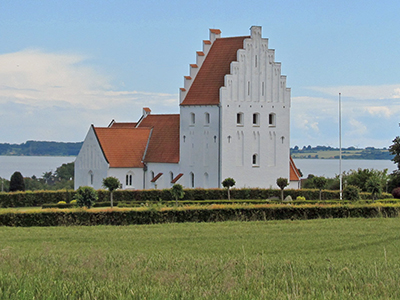
Rinkenæs Korskirke, a Lutheran church in Gråsten. The church was consecrated on September 4, 1932 and became a parish church from the same date. The church, designed by architect Harald Lønborg-Jensen, is built as a traditional village church with a red tile roof and a tower with a saddle roof and jagged gables.
Photo: Don & Maria Hitchcock 1342h 25th June 2014
Text: Wikipedia
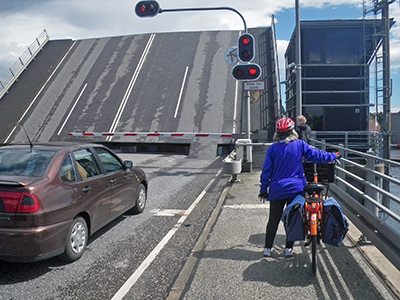
Crossing Nybøl Nor on highway 401 to Egernsund.
We waited at the lights while boats passed out to sea.
Photo: Don & Maria Hitchcock 1402h 25th June 2014
The two boats, for whom the bridge had opened, sailed on.
Photo: Don & Maria Hitchcock 1402h 25th June 2014
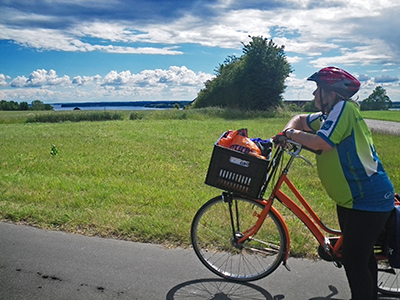
Rest stop on the way to Sønderborg, not far from Dybbøl Mill.
Photo: Don & Maria Hitchcock 1519h 25th June 2014
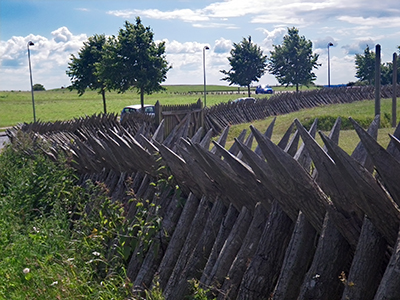
Part of the history centre, near Dybbøl Mill. The fences are recreations of the defences used in the war of 1864, when Prussia and Austria declared war upon Denmark in an attempt to take the Duchy of Schleswig.
Denmark, outmanned, outgunned, and outmanoeuvred, was defeated. The matter was not resolved with its present borders until after the First World War, when in 1920 the northern zone of Schleswig voted for union with Denmark, and central Schleswig voted for union with Germany.
Photo: Don & Maria Hitchcock 1525h 25th June 2014
Text: Adapted from Wikipedia
The Dybbøl Mill is a very important symbol of patriotism for the Danes. It was destroyed in the war of 1864 after serving as the last stronghold for the Danish troops. The owner rebuilt it, but suffered considerable loss, not being indemnified for the full value of the mill from war reparations.
The Dybbøl Mill had to be rebuilt once more after a fire in 1935. The mill continued, with changing tenants, until 1990. By 1995, the museum at Sønderborg Castle organised exhibitions in the mill as well as in the grain repository. The mill house next to the Dybbøl Mill was established in 2012 for the administration of the mill and the History Centre Dybbøl Banke.
Photo: Don & Maria Hitchcock 1527h 25th June 2014
Text: Adapted from https://1864.dk/en/dybboel-mille/the-history-of-the-mill/
From Maria's Diary:
At Sønderborg we found the tourist info office and a bank. We were advised of a campsite out of town so we set off again, stopping to do some shopping along the way.
We arrived in Sønderborg and were puzzled by the fact that firstly, there were so many teenagers around, and secondly, they were all wearing caps in what we took to be a nautical style.
It turns out that the student caps ( studenterhue ) are the last vestiges of the old school uniform of the University of Copenhagen. They came in two colours: black for the winter uniform and white for the summer uniform. The caps are now worn by Danish students who have completed an upper secondary level education. The student cap is made of linen with a black brim and is supplied with a band and a red and white cockade with a badge, the band colour and the badge varying depending on which examination it represents.
Photo: Don & Maria Hitchcock 1553h 25th June 2014
Additional text: Wikipedia
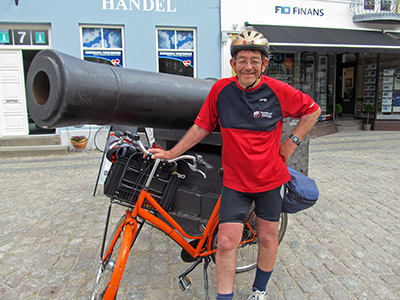
Looks like they had a lot of cannons left over from 1864!
Photo taken in Sønderborg.
Photo: Don & Maria Hitchcock 1614h 25th June 2014
From Maria's Diary:
The campsite was near the water and had a camp kitchen but you had to pay for the gas and hot water. I put money in for the shower and got a lukewarm reception - bad! We had a great chat to a Finnish couple.
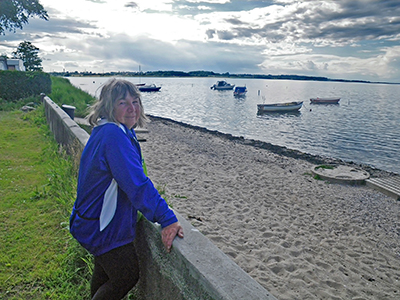
The site for our camp was great, and overlooked Augustenborg Fjord.
Photo: Don & Maria Hitchcock 1736h 25th June 2014
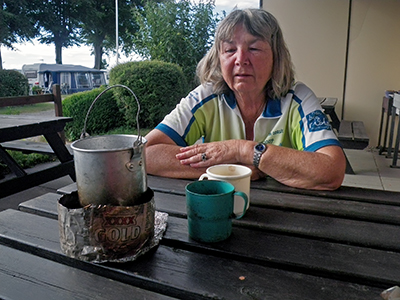
Waiting for the billy to boil....
Which only takes a few minutes on my stove.
Photo: Don & Maria Hitchcock 1736h 25th June 2014
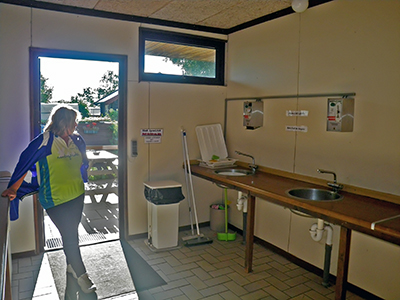
The signs in the camp kitchen read...
No fat down the drains
The fat from the pan is poured into the rubbish bin
The next cook demands a clean kitchen
Coin machine 2 Kr. coins
Fee for Gas or Micro-oven minimum - Kr. 1.50
Turn off the light, please
Fish waste must be wrapped in plastic
I have travelled extensively, and I have always found that, around the world, the more signs there are up at a campsite or hotel or motel room, the less pleasant is the experience.
In particular, I resent having to pay extra for what should be part of my booking fee. I don't mind paying extra for 'free' access to good facilities.
In addition, showers should be hot, not lukewarm, and every time I have had to pay extra for a hot shower, the result has always been less than satisfactory.
I understand that since 2017 the campsite is now under new owners, and has been comprehensively renovated.
Photo: Don & Maria Hitchcock 1736h 25th June 2014
Cycling from Amsterdam to Copenhagen
Day 14, 25th June 2014
51 km (713 km from the start)


